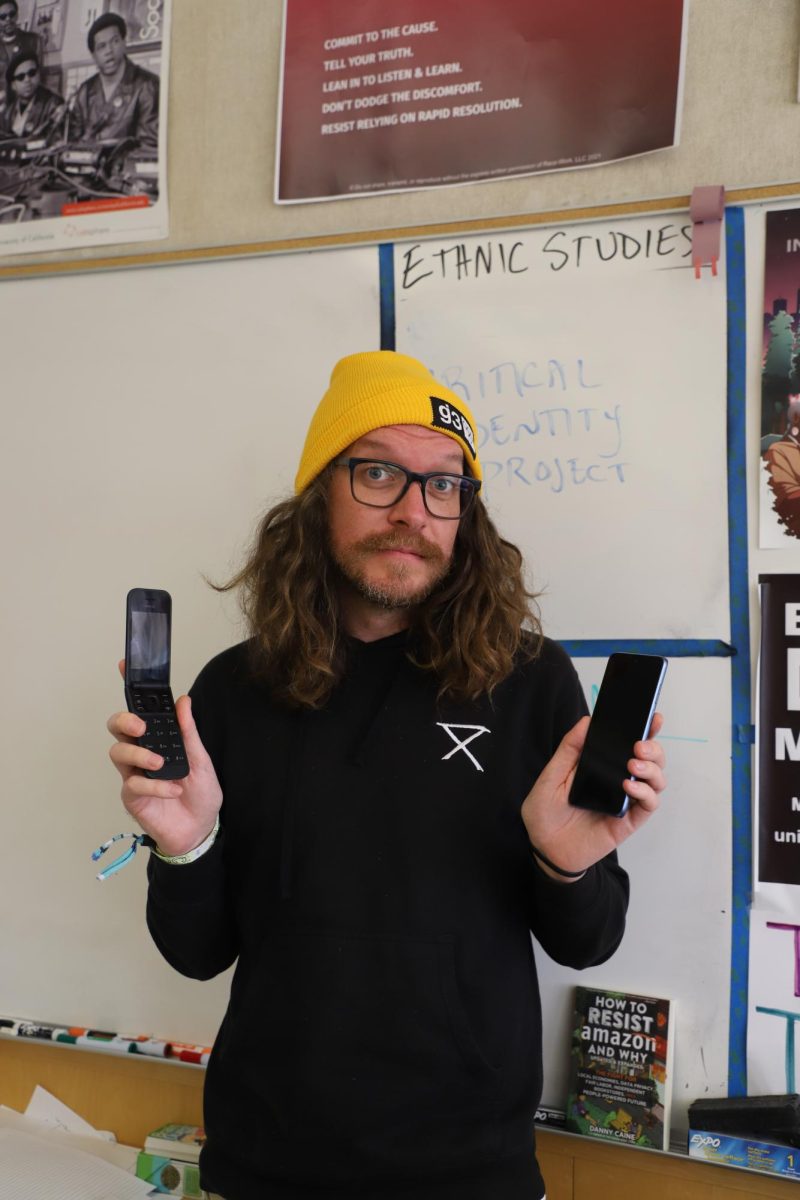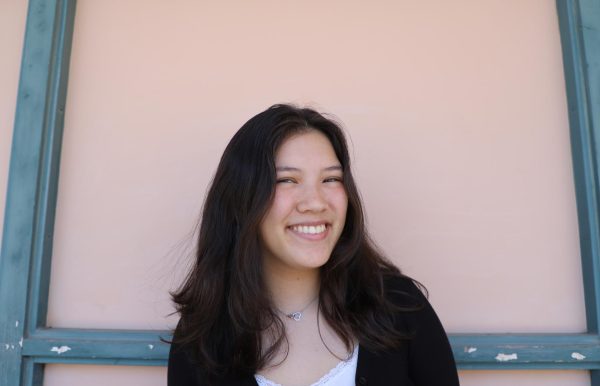This article is part of the Mirador’s first print issue. To view more articles in print, subscribe for access to six magazines a year!
July 9, 2024. Around 4 p.m. at Best Buy San Francisco on 13th and Harrison St.
At this completely ordinary Best Buy, on this completely ordinary day, something extraordinary happened: social studies teacher Matthew Sweeney purchased a smartphone.
I know what you’re thinking. Acquiring a new smartphone may seem like a trivial buy — a large purchase, yes, but certainly not worthy of a spot in The Mirador. But what if I told you that this shiny blue Motorola Moto G is the very first smartphone this 34-year-old teacher has ever owned?
When he was 13, Sweeney got his first phone: a Nokia 3310, more commonly known as a “Nokia brick.” (A note to our younger audience: this is the kind of phone where you had to press “1” three times to type the letter “C.”) Further into his teenage years, he received his first upgrade: his older sister’s hand-me-down Motorola flip phone. He has since then stuck with his trusty flip phones, with a few upgrades here and there as necessary.
Nokia brick by Nokia brick, Sweeney built his way up to his very first smartphone. Okay, maybe it’s not his VERY first — for about 24 hours in 2013, he owned an iPhone 5s.
“I used it for one night,” Sweeney said. “I think I sent a few text messages and looked on the internet for a minute, and then I was like, wow, I don’t think I need this, and I’ll never use this.”
The next day, Sweeney returned to the AT&T store to return his iPhone. Desperate to get it off his hands, he paid the exorbitant 35 dollar reshelving fee without a second thought.
I could continue on about Sweeney’s lengthy phone-ownership history, but I know what you really want to know: why? Why, after all those years of living without a smartphone, did he decide to hatch out of his dinosaur-age ways? Well, he didn’t exactly want to. But, as a chaperone for the 2024 Summer Europe trip, he needed an efficient way to contact his squad of students and other chaperones.
Sweeney recounts the moment he handed over his credit card to the Best Buy employee: “I was really disappointed,” he said. “I was disappointed with myself. I was disappointed that I had to, that I had to do this. I felt like such a jerk. I felt like such a tool.”
When Sweeney unwrapped the pristine packaging to his shiny new Motorola, his first action was uninstalling the preinstalled social media apps on his smartphone — a feature he described as “absolutely horrifying” and “offensive on so many levels.” Although a man of the future with his 2024 model phone, aspects of his flip phone lifestyle still linger.
Amidst my interview with Sweeney, Principal Ben Campopiano came into the room to voice his opinion. “Your life just improved dramatically, happiness levels have soared,” Campopiano said to Sweeney after hearing about the big purchase. “Food’s gonna taste better, he’s gonna get richer and healthier.”
Sweeney told himself that, in August after he returned from Europe, he would switch back to his old flip phone, tucked away neatly in his desk drawer. However, every morning the lockscreen of Sweeney’s Motorola Smartphone illuminates, reminding him that August truly has slipped away into a moment in time.
“It’s made certain things way more convenient,” Sweeney said. Participating in group texts, storing digital concert tickets, and sharing funny memes at trivia night are a few examples he gave.
“I’m disappointed that I am okay with liking it so much,” Sweeney said. “Yeah, I don’t want to be, I don’t want to be okay with it, but I am.”
And now, an exclusive Letter to the Editor from AP European History teacher Xavier Frippiat:
Mr. Sweeney proudly used his flip phone prior to this summer to ensure he would not succumb to the addictions most of us experience when using our iphones– whether doom scrolling through social media or perusing news headlines or accessing our work or personal emails, etc. but invariably escaping the world in which find ourselves, the great array of potential human interactions one could arguably experience while moving through the public realm, while shopping at Safeway, in line in a coffee shop, sitting among colleagues in a meeting. With this tremendous revolution in IT and communication, we could now reach out to so many more people and more frequently, came at the price of isolating us from those immediately around us. His flip phone was a symbol of defiance against the changes of our time, especially with regard to these, suggesting he was a great protector and preserver of the older, more authentic interpersonal interactions. His mind would not be seduced by the flickering kaleidoscope and bombardment of images these little computers offer in the palm of our hand. He would not submit to the new marketing and free from the gutter of behavior that feeds into attention deficit disorder.
Then came our summer plans, where we’d be traveling to Central and Eastern Europe with some 38 MHS students and I needed to count on him as an effective chaperone, communicator and manager of a squad of students. I strongly encouraged him to temporarily take up a smart phone to adequately meet that end and then he could, I argued, terminate his account once we got back. He acquiesced, but I could tell he felt conflicted. Eventually, just days before the flight, he texted me to inform me that he had finally come around emotionally to make the move and purchased some Android phone. Throughout this summer he indeed proved very effective and dependable as a chaperone, maintaining consistent contact with his squad and the larger group demonstrating an impressive versatility in group chats and Google Maps and in sharing photos, etc, especially for someone who days prior hadn’t even owned a smartphone. As a matter of fact, among chaperones, he became the reliable point person to make recommendations for restaurants or bars or to help us navigate through the meandering medieval streets of Prague, Krakow and Budapest. We honestly all benefited from his acquisition of this device well beyond simply chaperoning students and we commended him for it. Yet, despite this, I did see something change slowly. He increasingly tuned out some of our conversations while we were out at night. He’d stop walking some times and just randomly stared stoned faced at his phone, immovable and unreachable. He also appeared increasingly irritated by the smallest inconveniences, such as the various exchange rates we continually had to adjust to. The only cure it seemed would be to get him to ride an electric scooter, where his old self appeared resurrected, smiling and effusive while pointing out the sites, while his phone remained buried in his bag. We could hear him laugh again!
When we got back to California, yes, he told us that he was going to keep his phone. I strongly urged him to get rid of it because I didn’t want to be responsible for his further descent into this new obsession, but it was all in vain. He waved my comment off as one would shoo away a mosquito. I feared for his decision and evidence did slowly reinforce my concerns. During lunch, he’d keep his door locked more often and he would send to our group text a flurry of random pictures of the sort of food he was eating — from breakfast burritos to kale salads. Many of his text messages were unintelligible too — near gibberish. However, something has changed recently. He’s got a new vim and bounce to his gait and he seems quite cheery these days. So, I have to find out what has reset his relationship with his phone. Perhaps he met someone?
– XF






